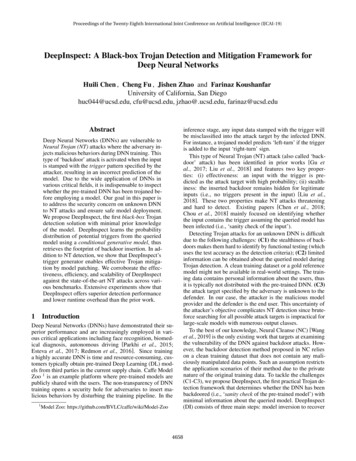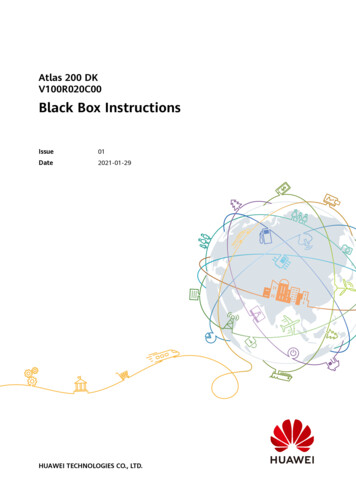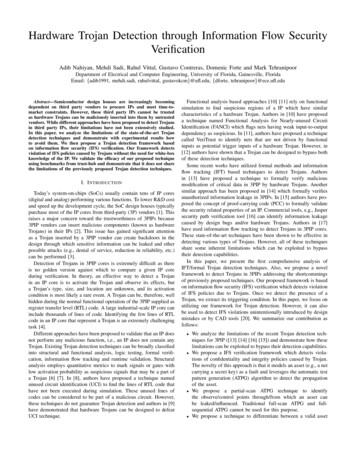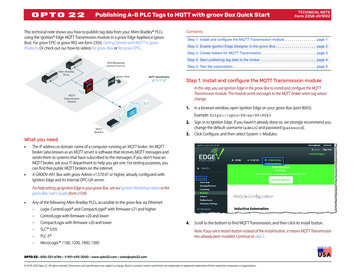
Transcription
Proceedings of the Twenty-Eighth International Joint Conference on Artificial Intelligence (IJCAI-19)DeepInspect: A Black-box Trojan Detection and Mitigation Framework forDeep Neural NetworksHuili Chen , Cheng Fu , Jishen Zhao and Farinaz KoushanfarUniversity of California, San Diegohuc044@ucsd.edu, cfu@ucsd.edu, jzhao@.ucsd.edu, farinaz@ucsd.eduAbstractDeep Neural Networks (DNNs) are vulnerable toNeural Trojan (NT) attacks where the adversary injects malicious behaviors during DNN training. Thistype of ‘backdoor’ attack is activated when the inputis stamped with the trigger pattern specified by theattacker, resulting in an incorrect prediction of themodel. Due to the wide application of DNNs invarious critical fields, it is indispensable to inspectwhether the pre-trained DNN has been trojaned before employing a model. Our goal in this paper isto address the security concern on unknown DNNto NT attacks and ensure safe model deployment.We propose DeepInspect, the first black-box Trojandetection solution with minimal prior knowledgeof the model. DeepInspect learns the probabilitydistribution of potential triggers from the queriedmodel using a conditional generative model, thusretrieves the footprint of backdoor insertion. In addition to NT detection, we show that DeepInspect’strigger generator enables effective Trojan mitigation by model patching. We corroborate the effectiveness, efficiency, and scalability of DeepInspectagainst the state-of-the-art NT attacks across various benchmarks. Extensive experiments show thatDeepInspect offers superior detection performanceand lower runtime overhead than the prior work.1IntroductionDeep Neural Networks (DNNs) have demonstrated their superior performance and are increasingly employed in various critical applications including face recognition, biomedical diagnosis, autonomous driving [Parkhi et al., 2015;Esteva et al., 2017; Redmon et al., 2016]. Since traininga highly accurate DNN is time and resource-consuming, customers typically obtain pre-trained Deep Learning (DL) models from third parties in the current supply chain. Caffe ModelZoo 1 is an example platform where pre-trained models arepublicly shared with the users. The non-transparency of DNNtraining opens a security hole for adversaries to insert malicious behaviors by disturbing the training pipeline. In the1Model Zoo: ference stage, any input data stamped with the trigger willbe misclassified into the attack target by the infected DNN.For instance, a trojaned model predicts ‘left-turn’ if the triggeris added to the input ‘right-turn’ sign.This type of Neural Trojan (NT) attack (also called ‘backdoor’ attack) has been identified in prior works [Gu etal., 2017; Liu et al., 2018] and features two key properties: (i) effectiveness: an input with the trigger is predicted as the attack target with high probability; (ii) stealthiness: the inserted backdoor remains hidden for legitimateinputs (i.e., no triggers present in the input) [Liu et al.,2018]. These two properties make NT attacks threateningand hard to detect. Existing papers [Chen et al., 2018;Chou et al., 2018] mainly focused on identifying whetherthe input contains the trigger assuming the queried model hasbeen infected (i.e., ‘sanity check of the input’).Detecting Trojan attacks for an unknown DNN is difficultdue to the following challenges: (C1) the stealthiness of backdoors makes them hard to identify by functional testing (whichuses the test accuracy as the detection criteria); (C2) limitedinformation can be obtained about the queried model duringTrojan detection. A clean training dataset or a gold referencemodel might not be available in real-world settings. The training data contains personal information about the users, thusit is typically not distributed with the pre-trained DNN. (C3)the attack target specified by the adversary is unknown to thedefender. In our case, the attacker is the malicious modelprovider and the defender is the end user. This uncertainty ofthe attacker’s objective complicates NT detection since bruteforce searching for all possible attack targets is impractical forlarge-scale models with numerous output classes.To the best of our knowledge, Neural Cleanse (NC) [Wanget al., 2019] is the only existing work that targets at examiningthe vulnerability of the DNN against backdoor attacks. However, the backdoor detection method proposed in NC relieson a clean training dataset that does not contain any maliciously manipulated data points. Such an assumption restrictsthe application scenarios of their method due to the privatenature of the original training data. To tackle the challenges(C1-C3), we propose DeepInspect, the first practical Trojan detection framework that determines whether the DNN has beenbackdoored (i.e., ‘sanity check of the pre-trained model’) withminimal information about the queried model. DeepInspect(DI) consists of three main steps: model inversion to recover
Proceedings of the Twenty-Eighth International Joint Conference on Artificial Intelligence (IJCAI-19)a substitution training dataset, trigger reconstruction usinga conditional Generative Adversarial Network (cGAN), andanomaly detection based on statistical hypothesis testing. Thetechnical contributions of this paper are summarized below: Enabling Neural Trojan detection of DNNs. We propose the first backdoor detection framework that inspectsthe security of a pre-trained DNN without the assistanceof a clean training data nor a ground-truth referencemodel. The minimal assumptions made by our threatmodel ensure the wide applicability of DeepInspect. Performing comprehensive evaluation of DeepInspect on various DNN benchmarks. We conduct extensive experiments to corroborate the efficacy, efficiency,and scalability of DeepInspect. We demonstrate thatDeepInspect is provably more reliable compared to theprior NT detection scheme [Wang et al., 2019]. Presenting a novel model patching solution for Trojan mitigation. The triggers recovered by the conditional generative model of DeepInspect shed light on thesusceptibility of the queried model. We show that the defender can leverage the trigger generator for adversarialtraining and invalidating the inserted backdoor.2Related WorkA line of research has focused on identifying the vulnerabilities of DNNs to various attacks including adversarial samples [Rouhani et al., 2018; Madry et al., 2017], data poisoning [Biggio et al., 2012; Rubinstein et al., 2009], and backdoor attacks [Gu et al., 2017; Liu et al., 2018]. We targetat backdoor attacks in this paper and provide an overview ofthe state-of-the-art NT attacks as well as the correspondingdetection methods below.2.1Trojan Attacks on DNNsBadNets [Gu et al., 2017] takes the first leap to identify thevulnerability in DNN supply chain. The paper demonstratesthat a malicious model provider can train a DNN that has highaccuracy on normal data samples but misbehaves on attackspecified inputs. Two types of backdoor attacks, single-targetattack and all-to-all attack, are presented in the paper assumingthe availability of the original training data. These two attacksare implemented by training the model on the poisoned datasetwhere data samples are mislabelled.TrojanNN [Liu et al., 2018] proposes a more advanced andpractical backdoor attack that is applicable when the adversarydoes not have access to the clean training data. Their attackfirst specifies the trigger mask and selects neurons that aresensitive to the trigger region. The value assignment for thetrigger mask is obtained such that the selected neurons havehigh activations. The training data is then recovered assumingthe confidence score of the target model is known. Finally, themodel is partially retrained on the mixture of the recoveredtraining data and the trojaned dataset crafted by the attacker.2.2DNN Backdoor DetectionNeural Cleanse [Wang et al., 2019] takes the first step toassess the vulnerability of a pre-trained DL model to backdoor4659Figure 1: Intuition behind DeepInspect Trojan detection. Here, weconsider a classification problem with three classes. Let AB denotethe perturbation required to move all data samples in class A to classB and A denote the perturbation to transform data points in allthe other classes to class A: A max( BA , CA ). A trojanedmodel with attack target A satisfies: A B , C while thedifference between these three values is smaller in a benign model.attacks. NC utilizes Gradient Descent (GD) to reverse engineerpossible triggers for each output class and uses the trigger size(l1 norm) as the criteria to identify infected classes. However,NC has the following limitations: (i). it assumes that a cleantraining dataset is available for trigger recovery using GD; (ii).it requires white-box access to the queried model for triggerrecovery; (iii). it is not scalable to DNNs with a large numberof classes since the optimization problem of trigger recoveryneeds to be repeatedly solved for each class. DeepInspect,on the contrary, simultaneously recovers triggers in multipleclasses without a clean dataset in a black-box setting, thusresolving all of the above constraints. As such, DeepInspectfeatures wider applicability and can be used as a third-partyservice that only requires API access to the model.33.1DeepInspect FrameworkOverview of Trojan DetectionThe key intuition behind DeepInspect is shown in Figure 1.The process of Trojan insertion can be considered as adding redundant data points near the legitimate ones and labeling themas the attack target. The movement from the original data pointto the malicious one is the trigger used in the backdoor attack.As a result of Trojan insertion, one can observe from Figure 1that the required perturbation to transform legitimate data intosamples belonging to the attack target is smaller comparedto the one in the corresponding benign model. DeepInspectidentifies the existence of such ‘small’ triggers as the ‘footprint’ left by Trojan insertion and recovers potential triggersto extract the perturbation statistics.Figure 2 illustrates the overall framework of DeepInspect.DI first employs the model inversion (MI) method in [Fredrikson et al., 2015] to generate a substitution training datasetcontaining all classes. Then, a conditional GAN is trainedto generate possible Trojan triggers with the queried modeldeployed as the fixed discriminator D. To reverse engineer the
Proceedings of the Twenty-Eighth International Joint Conference on Artificial Intelligence (IJCAI-19)Figure 2: Global flow of DeepInspect framework.Trojan triggers, DI constructs a conditional generator G(z, t)where z is a random noise vector and t is the target class. G istrained to learn the distribution of triggers, meaning that thequeried DNN shall predict the attack target t on the superposition of the inversed data sample x and G’s output. Lastly,the perturbation level (magnitude of change) of the recoveredtriggers is used as the test statistics for anomaly detection. Ourhypothesis testing-based Trojan detection is feasible since itexplores the intrinsic ‘footprint’ of backdoor insertion.3.2Figure 3: Illustration of DeepInspect’s conditional GAN training.Here, x is the input data, t is the target class to recover, fis the probability that the queried model predicts t given xas its input, AuxInf o(x) is an optional term incorporatingauxiliary constraints on the input.Trigger GenerationThe key idea of DeepInspect is to train a conditional generatorthat learns the probability density distribution (pdf) of theTrojan trigger whose perturbation level serves as the detectionstatistics. Particularly, DI employs cGAN to ‘emulate’ theprocess of the Trojan attack:D(x G(z, t)) t. Here, D isthe queried DNN, t is the examined attack target, x is a samplefrom the data distribution obtained by MI, and the trigger isthe output of the conditional generator G(z, t). Notethat existing attacks [Gu et al., 2017; Liu et al., 2018] thatuse fixed trigger patterns can be considered as a special casewhere the trigger distribution is constant-valued.Figure 3 shows the high-level overview of our trigger generator. Recall that DeepInspect deploys the pre-trained modelas the fixed discriminator D. As such, the key challenge oftrigger generation is to formulate the loss to train the conditional generator. Since our threat model assumes that the inputdimension and the number of output classes are known tothe defender, he can find a feasible topology of G that yieldstriggers with a consistent shape as the inversed input x. Toemulate the Trojan attack, DI first incorporates a negative loglikelihood loss (nll) shown in Eq. (2) to quantify the quality ofG’s output trigger to fool the pre-trained model D:Threat ModelDeepInspect examines the susceptibility of the queried DNNagainst NT attacks with minimal assumptions, thus addressingthe challenge of limited information (C2) mentioned in theprevious section. More specifically, we assume the defenderhas the following knowledge about the inquired DNN: dimensionality of the input data, number of output classes, and theconfidence scores of the model given an arbitrary input query.Furthermore, we assume the attacker has the capability ofinjecting arbitrary type and ratio poison data into the trainingset to achieve his desired attack success rate. Our strong threatmodel ensures the practical usage of DeepInspect in the realworld settings as opposed to the prior work [Wang et al., 2019]that requires a benign dataset to assist backdoor detection.3.3DeepInspect MethodologyDeepInspect framework consists of three main steps: (i)model inversion: the defender first applies model inversionon the queried DNN to recover a substitution training dataset{XM I , YM I } covering all output classes. The recovereddataset is used by GAN training in the next step, addressing the challenge C2; (ii) trigger generation: DI leverages agenerative model
DeepInspect: A Black-box Trojan Detection and Mitigation Framework for Deep Neural Networks Huili Chen, Cheng Fu, Jishen Zhao and Farinaz Koushanfar University of California, San Diego huc044@ucsd.edu, cfu@ucsd.edu, jzhao@.ucsd.edu, farinaz@ucsd.edu Abstract Deep Neural Networks (DNNs) are vulnerable to Neural Trojan (NT)attacks where the adversary in-jects malicious behaviors











